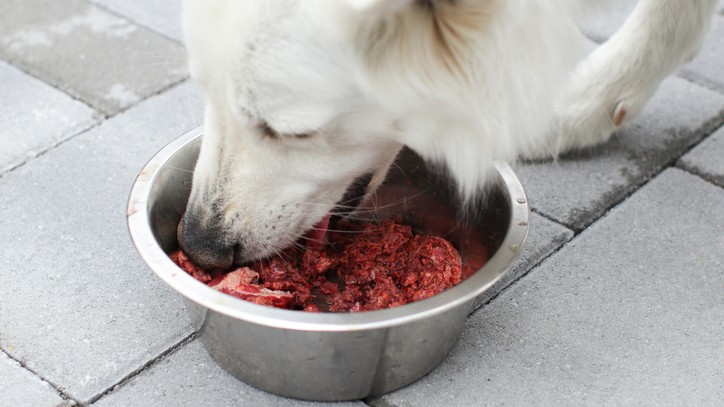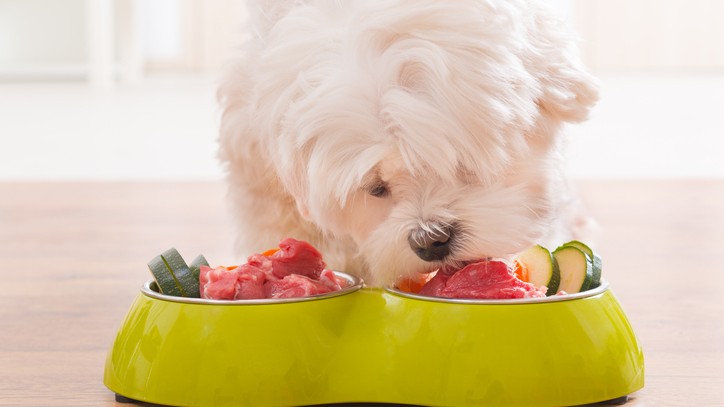What are the benefits of raw dog food? A vet's view
The benefits of raw dog food may not be as clear as you think. Our in-house vet gives an expert view…

The benefits of raw dog food are a common topic of discussion among dog owners, breeders, and pet retailers. In recent years, people have increasingly begun to consider “paleo” diets, gluten-free diets, and other dietary alternatives for their own consumption. Following these trends in human nutrition has led some dog owners to wonder whether there may also be a benefit to feeding their pets the best raw dog food instead of the best dry dog food or the best wet dog food.
Raw diets come in two forms: homemade or commercially-purchased. They typically include raw muscle meat (which may be fed on the bone), raw organ meat (including liver and kidneys), and vegetables. In some cases, raw diets also include eggs or dairy. Supporters of raw diets believe that these diets are more healthy than traditional commercial dog food, specifically because of the ingredients that are present in these diets and the fact that the ingredients are provided in an uncooked form.
Although there are many purported benefits of raw dog food, there is little evidence to support these claims. In contrast, studies of raw food diets have repeatedly found that raw diets predispose dogs to nutritional deficiencies and foodborne illness. Potentially serious bacteria and parasites are frequently found in raw food diets, posing a risk to both dogs and their human family members.
If you are considering a raw food diet for your dog, carefully consider both the pros and cons of these diets in order to make an educated decision. Evaluate the supposed benefits of these diets critically and carefully, while also remaining mindful of the risks that are inherent in this feeding practice.PL
The purported benefits of raw dog food

1. Homemade raw diets allow you to control the ingredients in your dog’s food.
When preparing a homemade raw diet, you have a great degree of control over what ingredients are included in the food. This can be beneficial, especially for dogs that require a limited-ingredient diet due to food allergies or other dietary sensitivities. Home-prepared foods may also be reassuring to dog owners who are concerned about preservatives, animal byproducts, or other ingredients that may be found in commercial dog food. (Interestingly, many ingredients that are identified as “byproducts” on dog food food labels, such as liver and kidney tissue, are intentionally added to raw diets!)
Commercial raw food diets may also be purchased, in refrigerated or freeze-dried forms. In this case, it is important to carefully research the food manufacturer and read the pet food label carefully, in order to ensure that you understand exactly what you are purchasing. Raw food manufacturers are typically required to adhere to the same labeling requirements as producers of conventional dry or canned dog foods.
2. Raw foods are associated with improved, shiny coats
Many dog owners feed a raw diet in order to make their dog’s coat appear more shiny. This shiny coat is typically caused by increased intake of essential fatty acids, which can occur in dogs being fed certain raw diets. (High levels of fatty acids are also found in high-quality commercial dog foods, although fatty acid concentrations may be lower in poor-quality foods.)
Get the best advice, tips and top tech for your beloved Pets
While fatty acids are beneficial for your dog’s skin and coat health, there is no evidence to suggest that cooking decreases their benefits. The same coat improvements that are seen with raw dog foods can also be seen with a high-quality commercial or homemade cooked diet, as long as adequate quantities of fatty acids are included. Fatty acids do not need to be raw to boost the appearance of your dog’s skin and coat.
3. Dogs eating a raw diet produce smaller bowel movements than dogs eating commercial diets
Raw food diets typically contain relatively low levels of fibre, compared to traditional commercial dog foods. Therefore, dogs that are fed a raw food diet often produce smaller, less bulky bowel movements than dogs eating a commercial diet. While this may or may not be advantageous for the dog, it certainly offers convenience for pet owners who must pick up their dog’s waste in their garden or on walks!
Again, it is important to note that similar benefits could be observed with any low-fibre diet. Small bowel movements are not an inherent characteristic of raw food; they simply reflect the low fibre content of a diet
4. Raw food diets can improve the body condition of overweight dogs
Raw food diets are primarily meat-based, tending to be lower in carbohydrates than conventional commercial dog foods. This may help promote weight loss in some overweight dogs.
In reality, however, the greatest weight loss benefit from raw food is probably associated with portion control. Whether an owner is preparing their dog’s food according to a precise recipe or feeding a small quantity of a fresh commercial raw diet, they are likely being more precise about their dog’s meal size than an owner who is dipping a large scoop into a 40-pound bag of dry dog food. This degree of “portion control” is probably a greater contributor to weight loss than the precise composition of the diet itself.
The veterinarian’s case against raw dog food

1. Raw food diets can make your dog sick
A number of studies, conducted in a variety of locations, have highlighted the risks associated with feeding a raw food diet.
Approximately ten years ago, the US Food and Drug Administration conducted a survey of foodborne illness in pet food. In this study, they found that commercially-available raw dog food diets are far more likely to be contaminated with foodborne pathogens than conventional commercial diets. In fact, nearly 10% of raw dog foods tested were positive for Salmonella and over 15% of tested samples were positive for Listeria monocytogenes. These foodborne bacteria are associated with significant gastrointestinal disease, cause vomiting, diarrhoea, and other signs of illness.
A 2018 study conducted in the Netherlands found that 23% of commercial raw diets contained E. coli 0157:H7, which is the strain that has been associated with serious, and even fatal, human illness. Additionally, 80% of raw diets contained antibiotic-resistant E. coli and 20% contained Salmonella.
Additionally, studies have also demonstrated that raw food diets in the UK and European Union may contain Brucella suis. This foodborne illness can cause fever, pain, lethargy, and decreased appetite in infected dogs and can also cause abortion in pregnant females.
These are just a few examples of documented risks associated with feeding raw food diets. There are certainly other risks, but the body of available research all seems to point towards significant foodborne illness risk associated with raw pet food.
2. Raw food diets can cause illness in human family members
Even if your dog remains healthy while eating a raw food diet, you and other members of your household may be at risk.
First, there is the risk inherent in handling a raw diet. Just like when you handle raw chicken or other raw meats, bacteria found in raw food may spread to your hands, countertops, and kitchen utensils. If you fail to appropriately clean contaminated surfaces and accidentally ingest this bacteria, you could become seriously ill.
Additionally, there is the possibility that your pet may spread infection to you after eating their meal. When your dog eats raw food, bacteria present in the food can contaminate their mouth, muzzle, and coat. If your dog gives you a big kiss or some loving cuddles after eating, these bacteria have now been spread to your face and hands.
Finally, dogs that are asymptomatically infected with Salmonella or another food-borne illness will shed the infection in their faeces. This form of spread can contaminate your environment, potentially spreading the illness to you or your family members.
3. Homemade raw diets may not be properly nutritionally balanced to meet your dog’s needs
Dogs require specific amounts of key nutrients in order to remain healthy. These nutrients include not only carbohydrates, proteins, and fats, but also micronutrients such as vitamins and minerals.
In many cases, homemade raw food diets are deficient in key micronutrients that are essential for normal, healthy development. Even if the correct nutrients are present, they are not always present in the correct quantities ratios. For example, calcium and phosphorus must not only be present in adequate amounts, they must also be present in a specific ratio that is determined by the dog’s life stage. Achieving the correct balance of nutrients for optimal growth and development is challenging and it is easy to miss the mark when feeding a homemade diet. If you feed any homemade diet, it is important to work closely with a veterinary nutritionist to ensure that your dog’s nutritional needs are being met appropriately.
4. Whole bones present in raw diets can cause internal damage
Many homemade diets include bones or other large ingredients that can damage your dog’s tissues. Chewing on bones is a common source of dental fractures in dogs. These tooth fractures are painful, and must be addressed with extractions or advanced dental procedures, such as a root canal.
Large fragments of bone that are swallowed can become lodged in your dog’s oesophagus, stomach, or intestines, leading to an obstruction that must be addressed through surgery. Smaller bone fragments, especially splintered bone fragments that may be caused by chewing on bones, can damage or even perforate the gastrointestinal tract as they pass through.
While bone material is a valuable source of calcium, feeding your dog whole bones presents a number of risks and should be avoided.
Raw dog food: Weigh the evidence carefully

While raw dog food is associated with a number of purported benefits, many of these benefits are unproven. Additionally, raw food diets are associated with a number of risks, which have been well-documented. Evaluate the pros and cons carefully before selecting a diet for your dog.
If you are looking to have more control over your dog’s diet while minimizing risk, consider working with a veterinary nutritionist to formulate a homemade cooked diet that is appropriate for your dog. This will allow you to have greater control over your dog’s diet, while minimizing the risk of foodborne illness and nutritional deficiencies or imbalances.
References
• Schlesinger DP, Joffe DJ. Raw food diets in companion animals: a critical review. Can Vet J. 2011;52(1):50-54.
• Food and Drug Administration. Get the Facts! Raw Pet Food Diets can be Dangerous to You and Your Pet.
• van Bree FPJ, Bokken GCAM, Mineur R, et al. Zoonotic bacteria and parasites found in raw meat-based diets for cats and dogs. Vet Rec. 2018;182(2):50. doi:10.1136/vr.104535
• Davies RH, Lawes JR, Wales AD. Raw diets for dogs and cats: a review, with particular reference to microbiological hazards. J Small Anim Pract. 2019;60(6):329-339. doi:10.1111/jsap.13000
• Kölle P, Schmidt M. BARF (Biologisch Artgerechte Rohfütterung) als Ernährungsform bei Hunden [Raw-meat-based diets (RMBD) as a feeding principle for dogs]. Tierarztl Prax Ausg K Kleintiere Heimtiere. 2015;43(6):409-420. doi:10.15654/TPK-150782
Dr. Barnette is a graduate of the University of Florida, where she received both her B.S. in Zoology and her Doctor of Veterinary Medicine (DVM). She has 15 years of clinical experience as a small animal veterinarian, treating dogs, cats, and occasional exotic patients. She now works as a freelance veterinary writer, creating educational content for veterinarians, veterinary team members, and dedicated pet owners. Dr. Barnette lives in southwest Florida with her husband and daughter (plus two cats, a dog, and a rescued dove!) and enjoys kayaking, biking, and hiking. Learn more about Dr. Barnette at www.linkedin.com/in/catherinebarnette.

